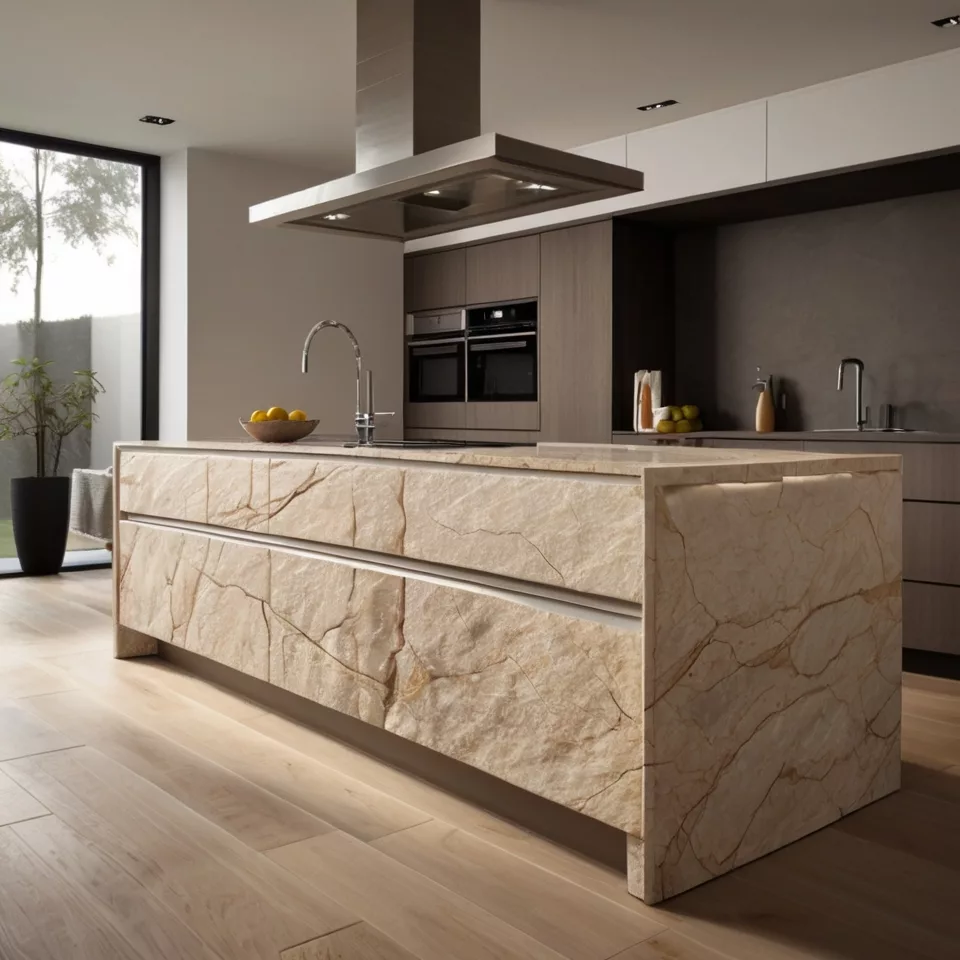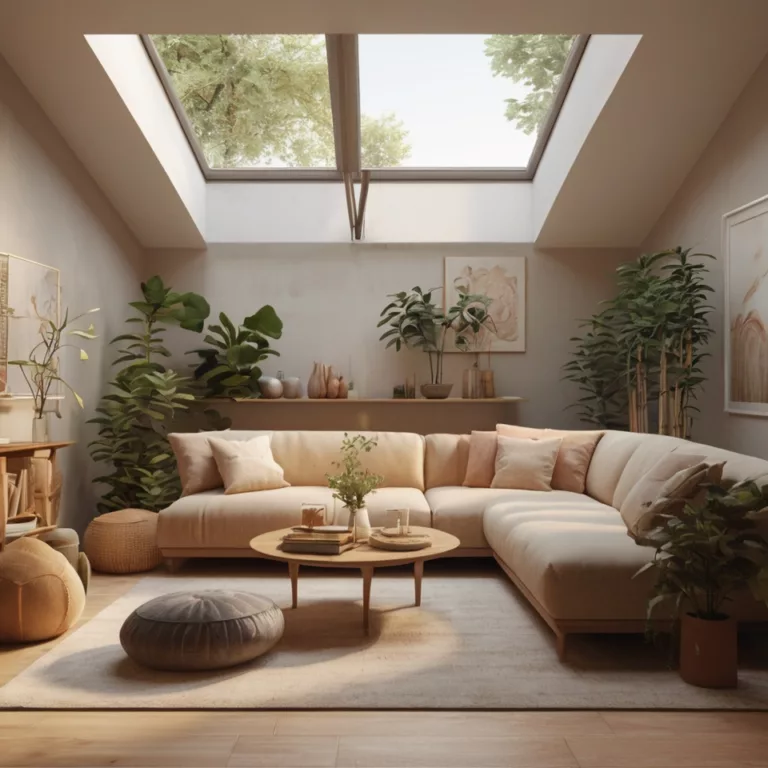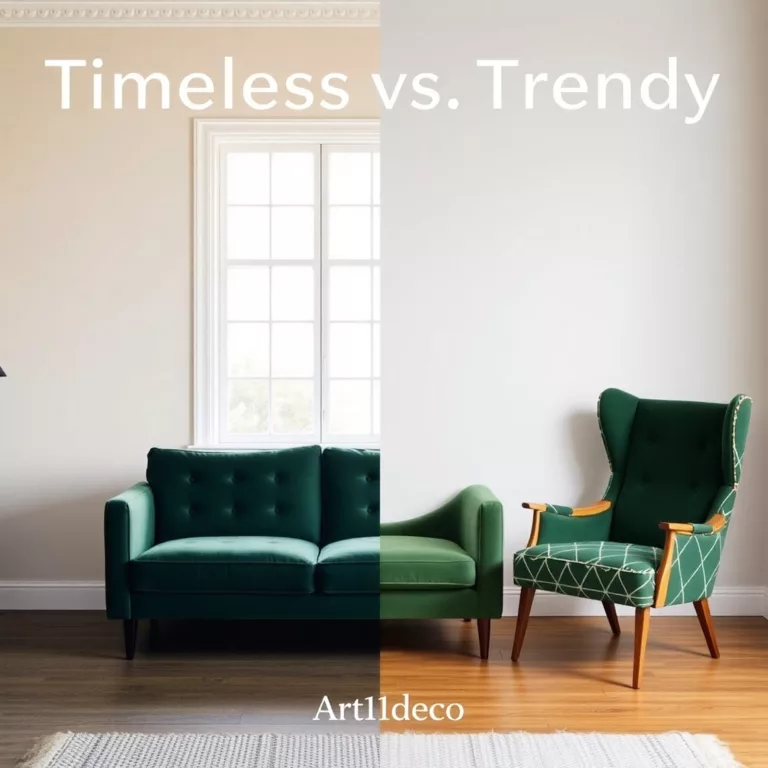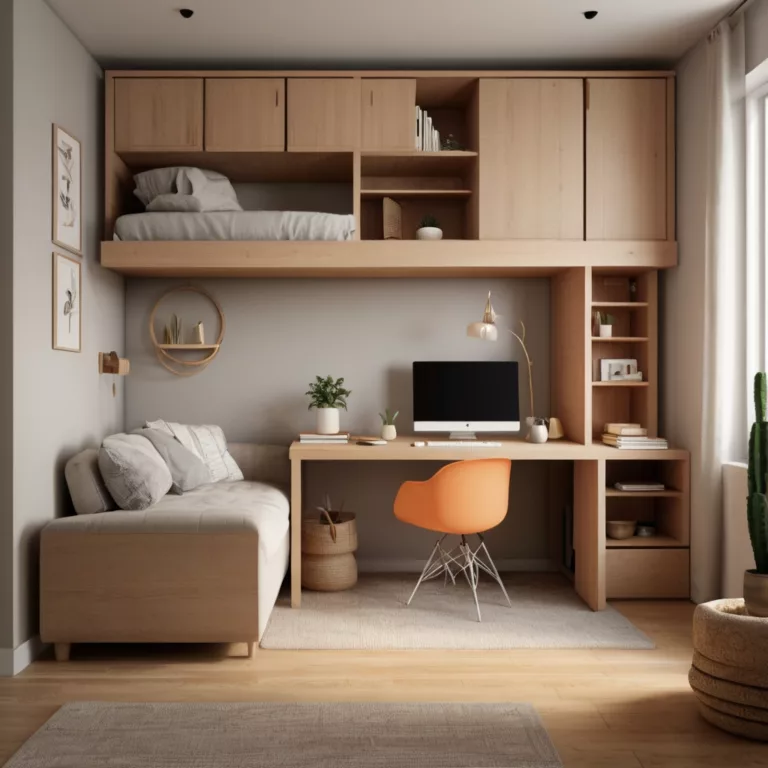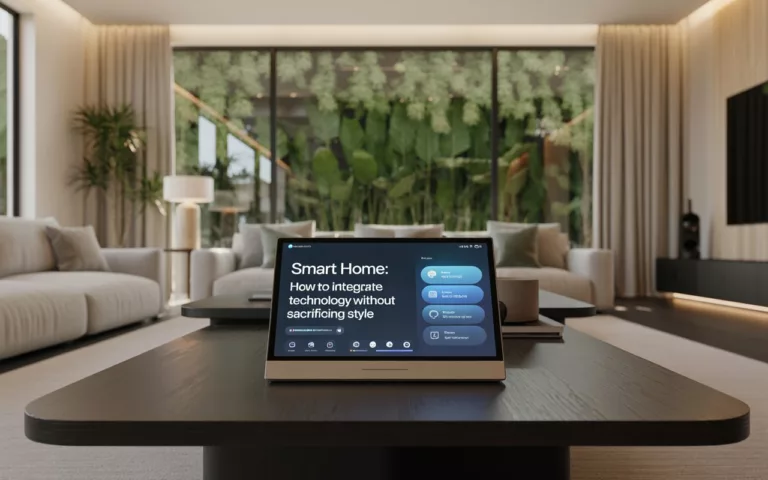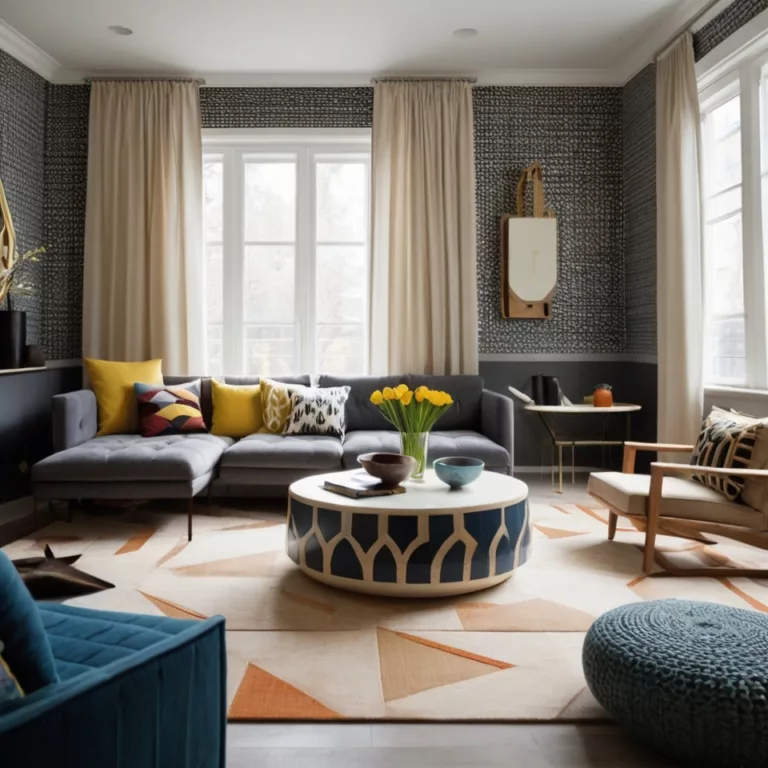Natural Stone in Interior Design has emerged as the cornerstone of luxury interior design, transforming ordinary spaces into extraordinary sanctuaries of elegance and sophistication. From the heart of the home in kitchen countertops to the serene retreat of bathroom vanities, natural stone brings unparalleled beauty, durability, and timeless appeal to every corner of modern living spaces.
Introduction to Natural Stone in Interior Design introduction
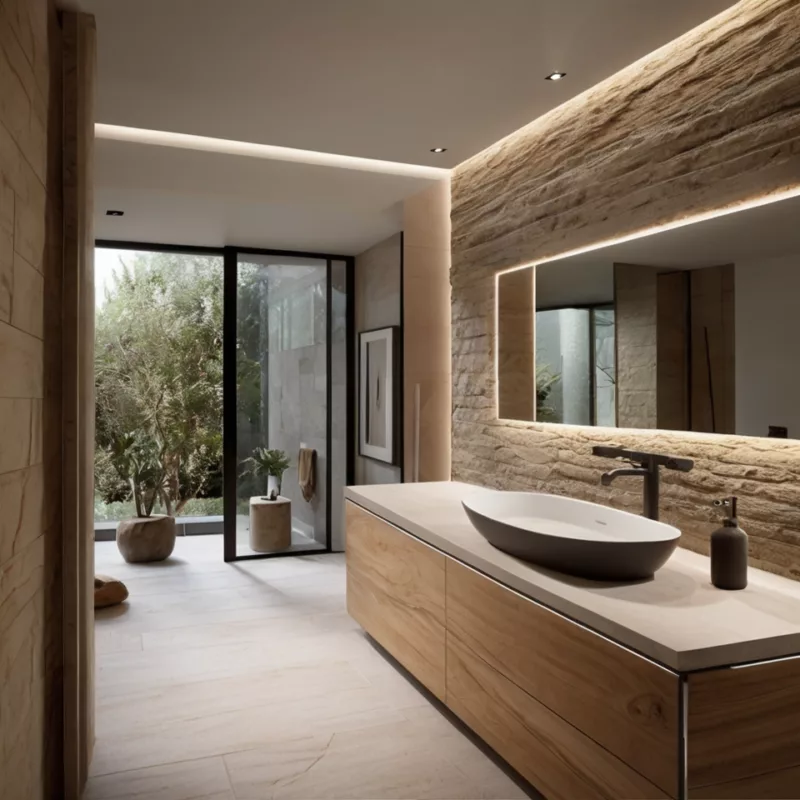
Natural stone represents the perfect marriage of nature’s artistry and human craftsmanship in interior design. This remarkable material has been cherished for millennia, adorning everything from ancient temples to contemporary luxury homes. The inherent beauty of natural stone lies in its unique characteristics – no two pieces are identical, creating one-of-a-kind installations that become the focal points of any space.
The appeal of natural stone extends far beyond its aesthetic qualities. Each type of stone tells a geological story, formed over millions of years through natural processes that create distinctive patterns, colors, and textures. When incorporated into interior design, natural stone brings a sense of permanence and connection to the natural world that synthetic materials simply cannot replicate.
Modern interior designers increasingly turn to natural stone as a solution for creating spaces that are both visually stunning and functionally superior. The material’s versatility allows it to seamlessly transition from rustic farmhouse kitchens to sleek contemporary bathrooms, making it an invaluable tool in the designer’s palette.
Types of Natural Stone for Interior Applications
Granite: The Epitome of Durability
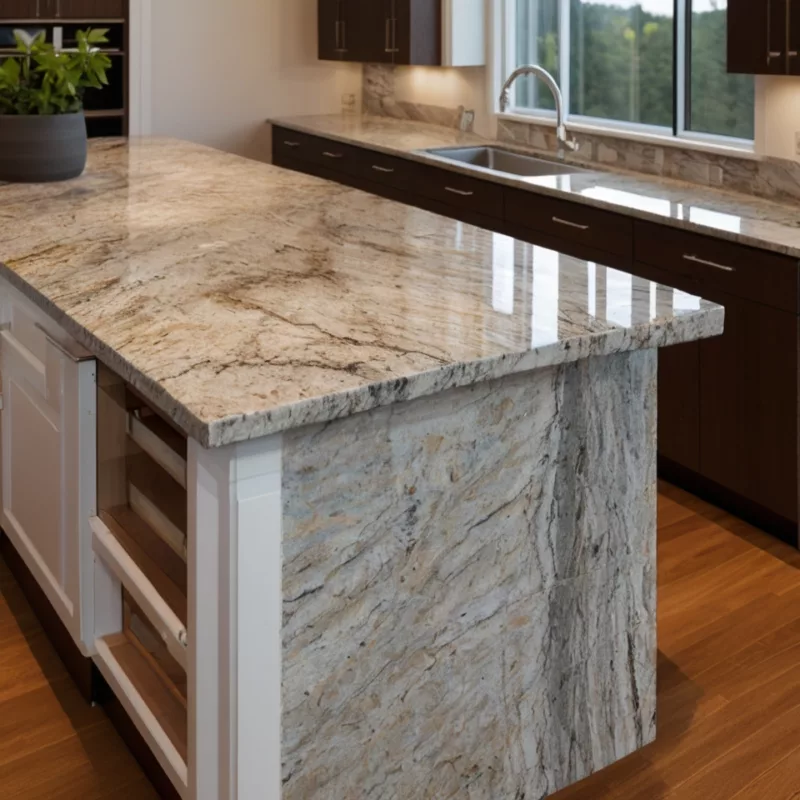
Granite stands as the most popular choice for natural stone applications in interior design, particularly in high-traffic areas like kitchens. This igneous rock formation offers exceptional hardness, ranking 6-7 on the Mohs scale, making it highly resistant to scratches, heat, and daily wear. The natural stone’s crystalline structure creates beautiful speckled patterns that range from subtle earth tones to dramatic contrasting colors.
The diversity of granite varieties available makes it suitable for virtually any design aesthetic. From the classic elegance of black granite with gold veining to the contemporary appeal of white granite with gray undertones, this natural stone provides options for every design preference. Brazilian granite varieties like Bianco Antico and Giallo Ornamental have become particularly sought after for their unique color combinations and consistent quality.
Marble: Timeless Luxury and Sophistication
Marble represents the pinnacle of luxury in natural stone applications. This metamorphic rock, formed from limestone or dolomite, offers unparalleled beauty with its characteristic veining patterns that seem to flow like frozen rivers across the surface. The natural stone’s softer composition (ranking 3-4 on the Mohs scale) makes it more susceptible to etching from acidic substances, but proper care and maintenance can preserve its beauty for generations.
Carrara marble from Italy remains the gold standard for luxury applications, while Calacatta marble offers more dramatic veining for statement pieces. Modern quarrying techniques have also introduced us to stunning varieties like Statuario marble and the increasingly popular book-matched slabs that create mirror-image patterns when properly installed.
Quartzite: The Perfect Balance
Quartzite represents an excellent compromise between the durability of granite and the beauty of marble. This natural stone forms when sandstone is subjected to extreme heat and pressure, creating a material that maintains the elegant appearance of natural stone while offering superior resistance to scratching, staining, and heat damage.
The natural stone’s popularity has surged in recent years as homeowners discover varieties like Super White, Taj Mahal, and Calacatta Viola that closely mimic the appearance of marble while providing the practical benefits of a harder stone. This makes quartzite an excellent choice for both kitchen countertops and bathroom vanities where beauty and functionality must coexist.
Limestone: Understated Elegance
Limestone offers a more subdued approach to natural stone applications, providing warm, neutral tones that create calming, sophisticated environments. This sedimentary rock typically features subtle color variations and occasional fossil inclusions that add character and visual interest to installations.
French limestone varieties like Chassagne Beige and Jerusalem Stone have become particularly popular for their consistent coloring and fine grain structure. The natural stone’s softer nature makes it ideal for areas where a more tactile, warm surface is desired, though it requires more careful maintenance than harder stones.
Travertine: Mediterranean Charm
Travertine brings the romantic appeal of Mediterranean architecture to modern interiors. This natural stone forms around hot springs and limestone caves, creating a unique porous structure that can be filled and polished for a smooth finish or left natural for a more rustic appearance.
The warm, earthy tones of travertine make it particularly suitable for creating spa-like bathroom environments and outdoor living spaces. Roman Travertine and Turkish Travertine varieties offer different color palettes and characteristics, allowing designers to select the perfect option for each specific application.
Natural Stone in Kitchen Design
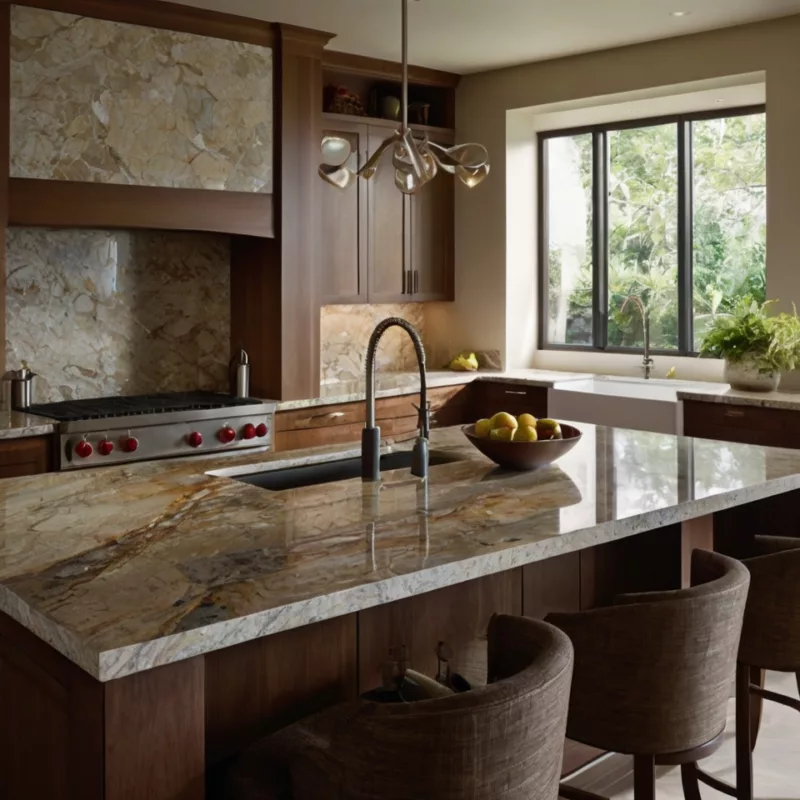
Countertops: The Crown Jewel of Kitchen Design
Granite countertops remain the most popular choice for natural stone kitchen applications due to their exceptional durability and heat resistance. The natural stone’s ability to withstand hot pots and pans without damage makes it ideal for serious cooking enthusiasts. Additionally, granite’s natural antimicrobial properties help maintain a hygienic food preparation surface when properly sealed.
The installation of natural stone countertops requires professional expertise to ensure proper support and seaming. Edge profiles can dramatically affect the overall appearance, with options ranging from simple eased edges to elaborate ogee profiles that showcase the stone’s natural beauty. Popular granite varieties for kitchen countertops include Uba Tuba, Venetian Gold, and Kashmir White, each offering unique color combinations and veining patterns.
Kitchen Islands: Statement Pieces in Natural Stone
Kitchen islands provide an excellent opportunity to showcase natural stone in a prominent way. The larger surface area allows for better display of the stone’s natural patterns and veining, while the island’s central location makes it a natural gathering point for family and friends.
Waterfall edges have become increasingly popular for natural stone kitchen islands, where the countertop material continues down the sides to create a seamless, flowing appearance. This design technique works particularly well with book-matched slabs, where adjacent pieces are cut from the same block and installed as mirror images to create stunning symmetrical patterns.
The choice of natural stone for kitchen islands often differs from the perimeter countertops, allowing designers to create visual interest and define different functional zones within the kitchen. Darker natural stone islands can anchor lighter perimeter countertops, while lighter island stones can brighten kitchens with darker cabinetry.
Backsplashes: Artistic Expression in Natural Stone
Natural stone backsplashes provide an opportunity to incorporate artistic elements into kitchen design while serving the practical purpose of protecting walls from cooking splatter. The vertical surface allows for creative installations that might not be practical on horizontal countertops.
Subway tile patterns in natural stone offer a classic, timeless look that complements various design styles. However, more elaborate patterns like herringbone, chevron, or mosaic designs can create stunning focal points that elevate the entire kitchen design. Natural stone backsplashes can incorporate multiple stone types or finishes to create visual depth and interest.
The scale of natural stone elements in backsplashes can vary dramatically, from small mosaic pieces that create intricate patterns to large format slabs that provide a seamless appearance. Honed finishes are often preferred for backsplash applications as they provide a more subtle appearance that doesn’t compete with polished countertops.
Kitchen Flooring: Natural Stone Foundations
Natural stone flooring in kitchens provides a durable, beautiful foundation that can withstand heavy foot traffic and occasional spills while maintaining its appearance for decades. The choice of natural stone for kitchen flooring must balance beauty with practicality, considering factors like slip resistance, stain resistance, and maintenance requirements.
Travertine and limestone tiles offer warm, inviting appearances that work well in traditional and transitional kitchen designs. The natural variation in these stones creates floors with character and visual interest that improve with age. However, these softer stones require regular sealing and more careful maintenance to prevent staining and etching.
Granite and slate tiles provide superior durability for kitchen flooring applications, with natural slip resistance that makes them safer choices for areas where water and cooking oils might create slippery conditions. The darker colors available in these natural stone options also help hide minor stains and wear patterns that inevitably occur in busy kitchens.
Bathroom Applications of Natural Stone
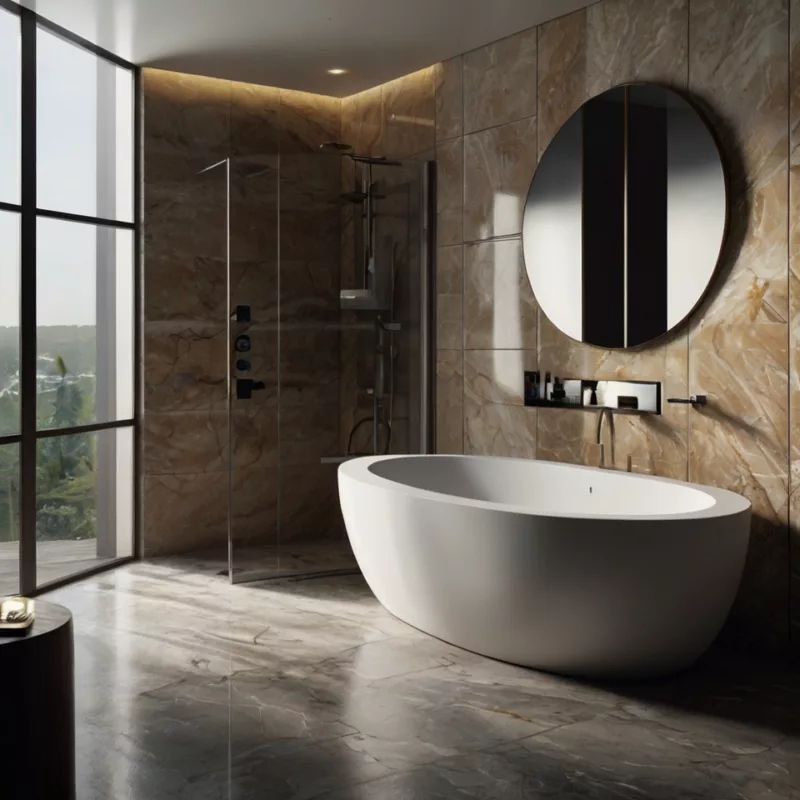
Vanity Tops: Luxury and Functionality Combined
Natural stone vanity tops transform ordinary bathrooms into spa-like retreats, providing both practical workspace and stunning visual appeal. The selection of natural stone for bathroom vanities requires consideration of the unique challenges presented by bathroom environments, including moisture, humidity, and daily grooming activities.
Granite and quartzite remain popular choices for natural stone vanity tops due to their durability and stain resistance. These harder stones can withstand the daily wear of grooming routines while resisting water damage and staining from common bathroom products. The wide variety of colors and patterns available in these natural stone options allows for coordination with various bathroom design schemes.
Marble vanity tops offer unparalleled luxury and beauty, though they require more careful maintenance due to the stone’s sensitivity to acidic substances. Proper sealing and regular maintenance can preserve marble’s beauty, making it a worthwhile investment for homeowners who appreciate its unique characteristics.
The edge details on natural stone vanity tops can significantly impact the overall bathroom design. Beveled edges create a refined, traditional appearance, while straight polished edges provide a more contemporary look. Integrated sinks carved from the same natural stone block create seamless, easy-to-clean installations that showcase the stone’s natural beauty.
Shower Surrounds: Creating Spa-Like Sanctuaries
Natural stone shower surrounds create luxurious bathing environments that rival the finest spas. The material’s natural beauty and durability make it ideal for wet environments, though proper installation and sealing are crucial for long-term performance.
Large format natural stone slabs for shower walls minimize grout lines and create seamless, easy-to-clean surfaces. Book-matched installations can create dramatic focal points within shower enclosures, while running the same natural stone from floor to ceiling creates a cohesive, enveloping environment.
Niche details carved from matching natural stone provide both functional storage and design continuity. These integrated features eliminate the need for aftermarket accessories while maintaining the shower’s clean, sophisticated appearance. Bench seating carved from natural stone adds both comfort and luxury to shower installations.
Different finishes can be used strategically within natural stone shower installations. Honed finishes on walls provide slip resistance and a softer appearance, while polished accents on niches and benches add visual interest and easier cleaning. Textured finishes on shower floors ensure safety while maintaining the natural stone’s aesthetic appeal.
Bathroom Flooring: Beauty Meets Practicality
Natural stone bathroom flooring must balance beauty with safety and practicality. The material’s natural variations and textures can provide slip resistance while creating visually stunning floors that enhance the entire bathroom design.
Tumbled natural stone tiles offer excellent slip resistance for bathroom flooring while providing rustic charm and character. The irregular surfaces and edges create floors with personality that work particularly well in traditional and Mediterranean-inspired bathroom designs. These treatments also help hide minor wear and water spots that might be more visible on polished surfaces.
Mosaic installations using natural stone create opportunities for intricate patterns and designs that can serve as artwork for bathroom floors. Hexagonal, penny round, and basketweave patterns are popular choices that allow for creative expression while maintaining the practical benefits of natural stone flooring.
Radiant heating systems integrate beautifully with natural stone bathroom flooring, as the stone’s thermal mass helps distribute heat evenly throughout the space. This combination creates luxurious, warm floors that enhance the spa-like atmosphere of natural stone bathrooms.
Living Spaces and Natural Stone Integration
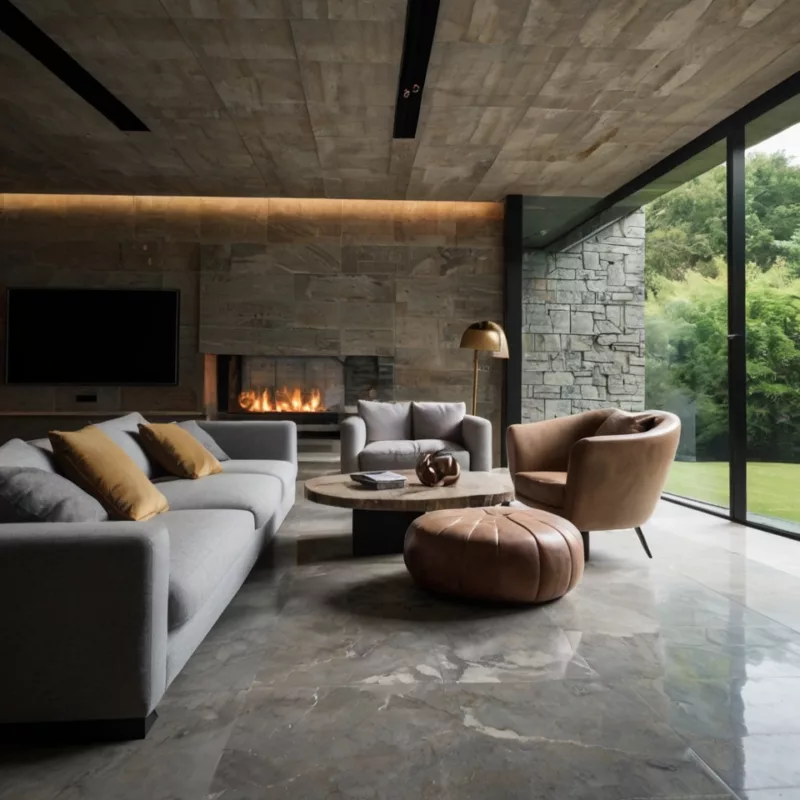
Fireplace Surrounds: Natural Stone as Focal Points
Natural stone fireplace surrounds create dramatic focal points that anchor living spaces and provide gathering places for family and friends. The material’s natural fire resistance and timeless beauty make it the perfect choice for these high-impact installations.
Stacked stone installations offer texture and visual interest that work well in both traditional and contemporary living spaces. The natural variations in color and size create dynamic surfaces that catch and reflect light throughout the day. These installations can extend from floor to ceiling to create impressive accent walls that frame entertainment centers or artwork.
Smooth, polished natural stone surrounds provide more formal, elegant appearances suitable for traditional living rooms and dining areas. Materials like marble and granite can be carved into elaborate mantels and decorative elements that showcase the stone’s natural beauty while providing architectural interest.
The scale of natural stone fireplace installations can vary dramatically based on the room’s proportions and design goals. Massive natural stone chimneys create rustic, cabin-like atmospheres, while sleek, linear installations complement contemporary furnishings and architectural elements.
Accent Walls: Dramatic Natural Stone Features
Natural stone accent walls create stunning focal points that add texture, color, and visual interest to living spaces without overwhelming the overall design. These installations allow homeowners to incorporate natural stone’s beauty in areas where full-wall coverage might be impractical or excessive.
Ledger stone panels provide easy installation options for natural stone accent walls while maintaining authentic appearance and texture. These stacked installations create shadow lines and depth that add visual interest to flat wall surfaces. The natural color variations within each stone type ensure that no two installations appear identical.
Large format natural stone slabs can create dramatic accent walls with minimal grout lines and maximum impact. Book-matched installations are particularly effective for accent walls, as the symmetrical patterns create stunning visual effects that serve as artwork for the space.
Backlighting natural stone accent walls can create dramatic effects that highlight the stone’s translucent qualities and natural patterns. This technique works particularly well with onyx and certain marble varieties that exhibit natural translucency when illuminated from behind.
Natural Stone Flooring Solutions
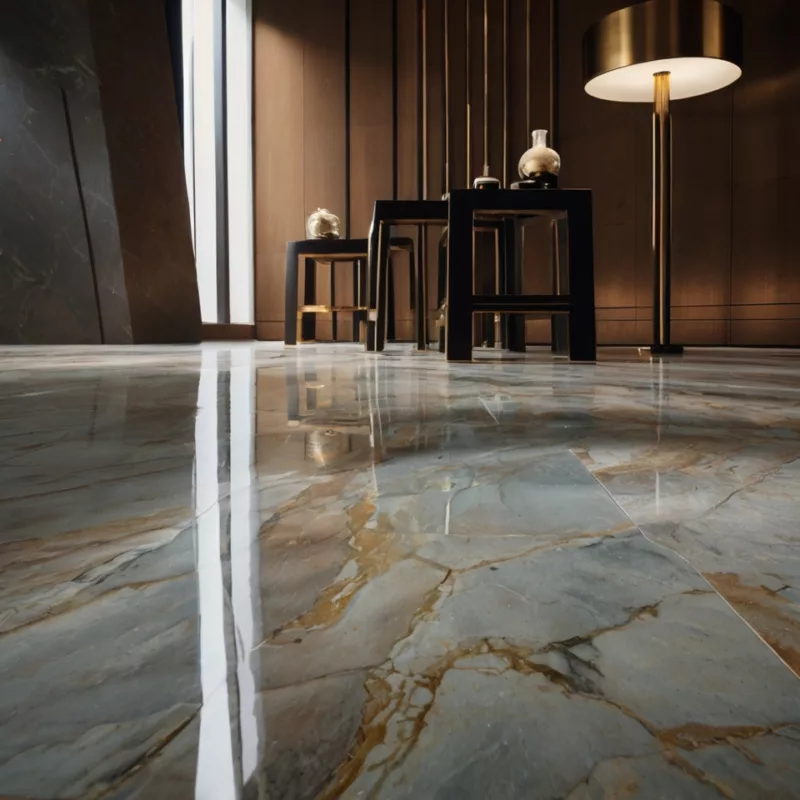
Entrance Areas: Making First Impressions Count
Natural stone flooring in entrance areas creates impressive first impressions while providing durable surfaces that can withstand heavy traffic and harsh weather conditions. The material’s natural beauty welcomes guests while its practical properties ensure long-lasting performance.
Granite and quartzite tiles provide exceptional durability for high-traffic entrance areas while offering slip resistance and easy maintenance. The natural variations in these stones help disguise minor scratches and wear patterns that inevitably occur in these busy areas.
Pattern installations using natural stone can create impressive entrance features that reflect the home’s overall design aesthetic. Medallion patterns, border designs, and contrasting stone combinations can transform entrance areas into stunning architectural features that set the tone for the entire home.
The transition between natural stone entrance flooring and other flooring materials throughout the home requires careful planning and execution. Matching height profiles and creating smooth transitions ensure both aesthetic appeal and practical functionality for daily use.
Great Rooms: Unifying Natural Stone Elements
Natural stone flooring in great rooms provides unifying elements that connect various functional areas while creating cohesive design schemes. The material’s versatility allows it to complement various furnishing styles while providing durable surfaces for heavy furniture and active family use.
Large format natural stone tiles minimize grout lines and create seamless appearances that make spaces appear larger and more sophisticated. These installations work particularly well in open-concept homes where flooring continuity helps define different functional areas without creating visual barriers.
Radiant heating systems complement natural stone flooring beautifully, as the stone’s thermal mass provides even heat distribution and comfortable walking surfaces throughout cooler months. This combination creates energy-efficient heating solutions that enhance both comfort and luxury.
Area rug placement over natural stone flooring allows for seasonal decoration changes and acoustic improvements while preserving the stone’s natural beauty. The contrast between soft textiles and hard stone surfaces creates interesting design juxtapositions that add depth and character to living spaces.
Wall Applications and Accent Features
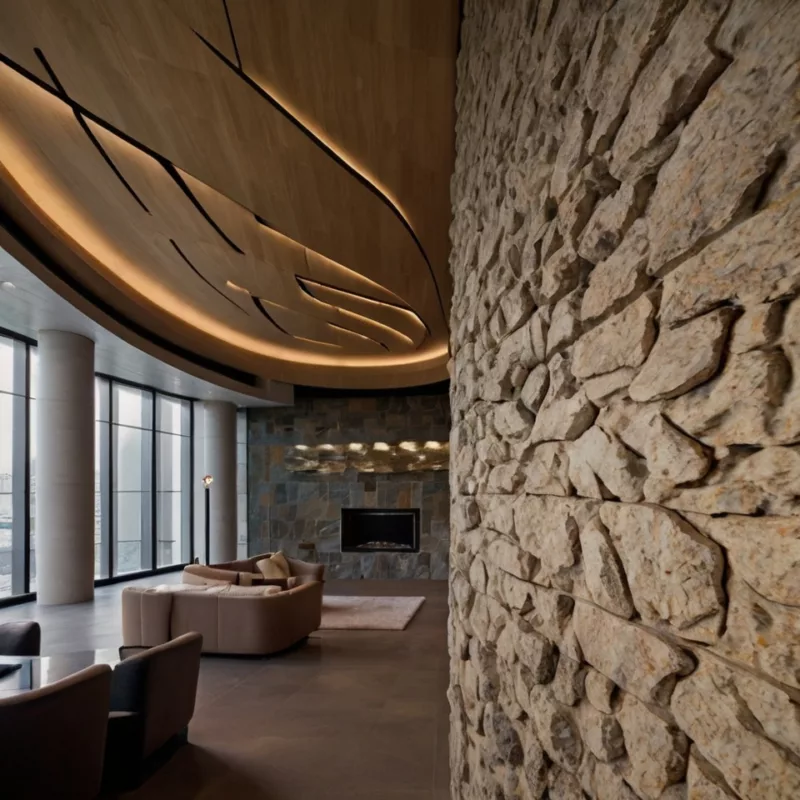
Feature Walls: Architectural Drama in Natural Stone
Natural stone feature walls create architectural drama that transforms ordinary rooms into extraordinary spaces. These installations serve as artistic elements that provide texture, color, and visual interest while showcasing the stone’s natural beauty and unique characteristics.
Dry-stacked natural stone walls offer rustic charm and authentic texture that work particularly well in casual living spaces and outdoor areas. These installations celebrate the stone’s natural shapes and variations while creating surfaces that invite touch and close examination.
Mortared natural stone installations provide more formal appearances suitable for elegant living and dining areas. The uniform grout lines create geometric patterns that complement the stone’s natural variations while ensuring structural stability and long-term durability.
Mixed-material installations combining natural stone with other elements like wood, metal, or glass create contemporary design statements that highlight each material’s unique properties. These combinations allow for creative expression while maintaining the natural stone’s prominence in the overall design.
Columns and Architectural Elements
Natural stone columns and architectural elements add classical elegance and structural emphasis to interior spaces. These features can serve both decorative and functional purposes while creating impressive focal points that anchor room designs.
Carved natural stone capitals and bases showcase the material’s workability and the craftsman’s skill while providing authentic architectural details that connect contemporary spaces with classical design traditions. These elements work particularly well in formal dining rooms and entrance halls.
Fluted natural stone columns create vertical emphasis and rhythm within spaces while providing sophisticated architectural details that complement various design styles. The interplay of light and shadow across these surfaces adds visual interest throughout the day as lighting conditions change.
Load-bearing natural stone elements must be engineered properly to ensure structural safety while maintaining aesthetic appeal. Professional installation and structural engineering ensure these impressive features perform their intended functions while providing lasting beauty.
Maintenance and Care Guidelines
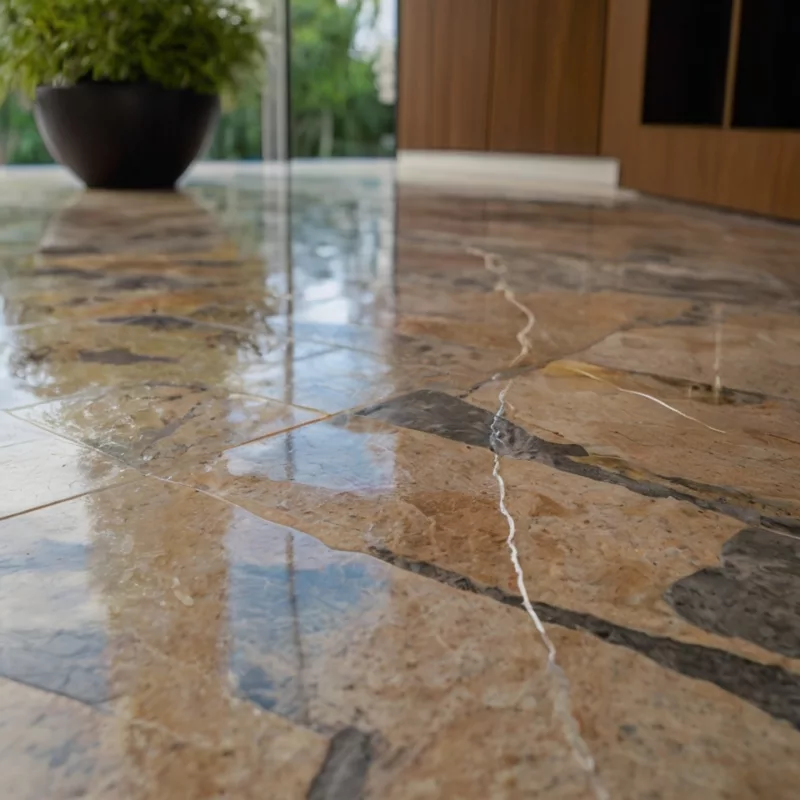
Daily Cleaning and Routine Maintenance
Proper daily cleaning and routine maintenance preserve natural stone’s beauty and extend its lifespan significantly. Understanding each stone type’s specific requirements ensures appropriate care that prevents damage while maintaining the material’s appearance.
pH-neutral cleaners specifically formulated for natural stone prevent etching and dulling that can occur with household cleaners containing acids or alkaline substances. These specialized products maintain the stone’s natural luster while effectively removing daily soil and residue.
Immediate cleanup of spills prevents staining and etching, particularly important for softer stones like marble and limestone. Blotting rather than wiping prevents spreading liquids across larger areas and reduces the risk of permanent staining.
Microfiber cloths and soft brushes provide effective cleaning without scratching or abrading natural stone surfaces. These tools remove dirt and debris while preserving the stone’s finish and preventing the micro-scratches that can dull polished surfaces over time.
Sealing and Protection Strategies
Regular sealing provides crucial protection for natural stone surfaces, creating barriers that prevent staining and make routine cleaning more effective. The frequency of sealing depends on the stone type, finish, and usage patterns, with high-traffic areas requiring more frequent attention.
Penetrating sealers absorb into the stone’s pores to provide protection without altering the natural appearance or texture. These products maintain the stone’s breathability while preventing liquid absorption that can lead to staining and damage.
Topical sealers create surface barriers that provide additional protection for heavily used areas but may alter the stone’s appearance and texture. These products work well for floors and other horizontal surfaces that experience heavy wear and frequent exposure to liquids.
Professional sealing services ensure proper application and optimal protection, particularly important for valuable installations and areas where failure could result in significant damage or costly repairs.
Restoration and Repair Techniques
Professional restoration techniques can address various types of damage to natural stone surfaces, often returning them to like-new condition. Understanding available options helps homeowners make informed decisions about maintenance and repair investments.
Polishing and honing services can remove scratches, etching, and dulling from natural stone surfaces while restoring their original luster and smoothness. These processes remove thin layers of stone to eliminate surface damage and reveal fresh, undamaged material beneath.
Crack repair and patching techniques can address structural damage and restore the stone’s integrity and appearance. Professional repairs using matching materials and proper techniques often make damage virtually invisible while preventing further deterioration.
Color enhancement and stain removal services can address discoloration and stubborn stains that regular cleaning cannot eliminate. These specialized treatments often restore the stone’s original appearance while providing guidance for preventing future problems.
Cost Considerations and Investment Value
Initial Investment Analysis
Natural stone installations represent significant initial investments that require careful consideration of material costs, installation expenses, and long-term value propositions. Understanding these factors helps homeowners make informed decisions that balance budget constraints with design goals.
Material costs vary significantly based on stone type, rarity, origin, and quality factors. Domestic stones typically cost less than imported varieties, while exotic stones with unique characteristics command premium prices. Thickness and finish options also impact material costs significantly.
Installation costs depend on project complexity, accessibility, and local labor rates. Simple installations cost less than elaborate patterns or custom fabrication, while difficult access or structural modifications increase labor expenses substantially.
The total project cost should include all related expenses like support structures, plumbing modifications, electrical work, and finishing details that may be necessary for proper installation and optimal performance.
Long-Term Value and Return on Investment
Natural stone installations typically provide excellent long-term value through durability, timeless appeal, and positive impact on property values. These factors often justify the initial investment through reduced replacement costs and enhanced marketability.
Properly maintained natural stone surfaces can last for decades or centuries, providing cost-per-year values that compare favorably with less durable alternatives. The material’s ability to be restored rather than replaced further enhances its long-term value proposition.
Market research consistently shows that natural stone installations, particularly in kitchens and bathrooms, provide strong returns on investment when homes are sold. Buyers recognize and value natural stone’s quality and durability, often viewing these installations as luxury features worth premium prices.
Energy efficiency benefits from natural stone’s thermal mass properties can provide ongoing savings through reduced heating and cooling costs, particularly when combined with radiant heating systems or in climates with significant temperature variations.
Budget-Friendly Natural Stone Options
Several strategies can make natural stone more accessible for budget-conscious homeowners without sacrificing quality or beauty. Understanding these options expands natural stone’s appeal to broader market segments.
Domestic stone varieties often provide excellent quality at lower prices than imported alternatives. American granite, marble, and limestone can offer beautiful options that support local economies while reducing transportation costs and environmental impact.
Tile installations typically cost less than slab installations while still providing natural stone’s beauty and durability. Smaller format tiles also offer more design flexibility and easier installation in complex areas or retrofit situations.
Remnant pieces from larger projects can provide cost-effective materials for smaller installations like bathroom vanities, fireplace hearths, or accent features. These pieces offer the same quality as full slabs at reduced prices due to their size limitations.
Design Trends and Future Outlook
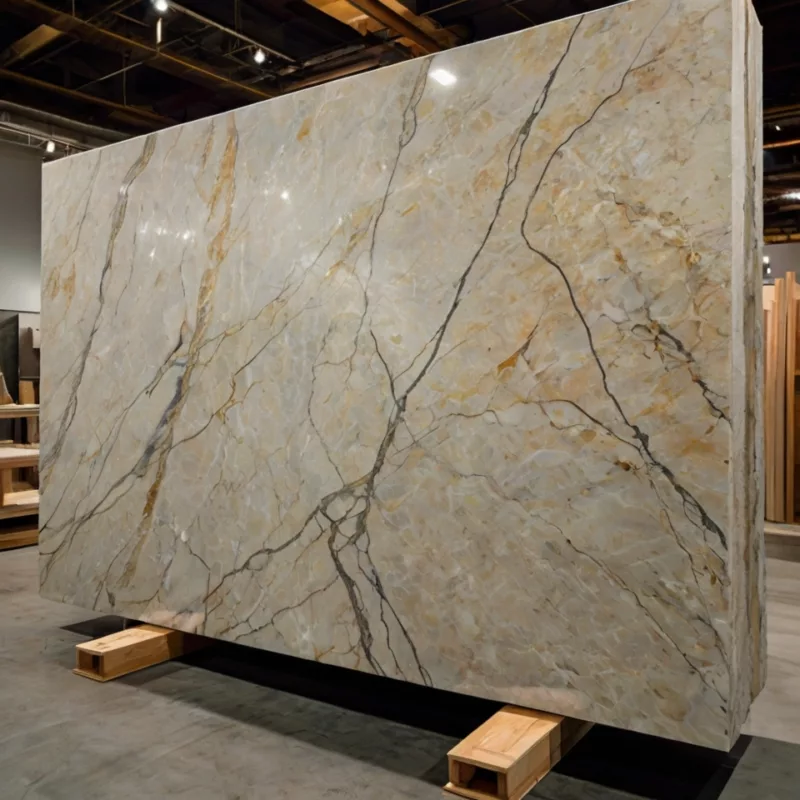
Contemporary Natural Stone Applications
Minimalist installations focus on natural stone’s inherent beauty without elaborate edge treatments or decorative elements. These clean, simple designs allow the stone’s natural patterns and colors to serve as the primary decorative elements while creating serene, uncluttered environments.
Mixed-finish installations combine different surface treatments on the same stone type to create visual interest and textural contrast. Honed and polished areas within the same installation provide subtle variation while maintaining material continuity.
Thin-slab technology allows for natural stone applications in areas where weight and thickness were previously prohibitive. These thinner materials maintain the stone’s natural beauty while expanding installation possibilities and reducing structural requirements.
Sustainable and Eco-Friendly Practices
Environmental consciousness increasingly influences natural stone selection and installation practices, driving innovations that reduce environmental impact while maintaining quality and beauty standards.
Local sourcing reduces transportation costs and environmental impact while supporting regional economies and craftsmanship traditions. Domestic natural stone varieties often provide excellent alternatives to imported materials with reduced carbon footprints.
Recycling and reclamation practices give new life to natural stone from demolished buildings and renovated spaces. These materials often possess character and patina that new stone cannot replicate while providing cost savings and environmental benefits.
Water-based sealing and finishing products reduce volatile organic compounds and improve indoor air quality while providing effective protection for natural stone surfaces. These environmentally friendly products perform as well as traditional alternatives while supporting healthier living environments.
Technology Integration and Smart Features
Emerging technologies enhance natural stone’s functionality while preserving its natural beauty and traditional appeal. These innovations expand the material’s capabilities while maintaining its timeless aesthetic qualities.
Integrated lighting systems highlight natural stone’s translucent properties and natural patterns while providing functional illumination for tasks and ambiance. LED technology offers energy-efficient options that generate minimal heat while providing precise color control and dimming capabilities.
Heated natural stone surfaces provide comfort and luxury while reducing energy consumption through thermal mass properties. Radiant heating systems integrated beneath stone floors and countertops create comfortable environments while maintaining the material’s natural appearance.
Smart home integration allows for automated maintenance reminders, environmental monitoring, and system controls that help preserve natural stone installations while providing convenient management of related systems and features.
Conclusion
Natural stone continues to reign supreme in interior design applications, from kitchen countertops to bathroom vanities and beyond. Its unique combination of natural beauty, exceptional durability, and timeless appeal ensures its position as a premier choice for discerning homeowners and designers.
The versatility of natural stone allows it to adapt to virtually any design style while providing functional benefits that synthetic alternatives cannot match. Whether creating dramatic focal points with book-matched marble slabs or providing durable work surfaces with granite countertops, natural stone delivers both aesthetic and practical value.
As technology and design trends continue to evolve, natural stone adapts and incorporates new innovations while maintaining its essential character and appeal. The material’s sustainability, longevity, and beauty ensure its continued prominence in high-quality interior design for generations to come.
The investment in natural stone represents more than simply selecting building materials – it’s choosing to incorporate elements of natural beauty and geological history into daily living spaces. This connection to the natural world, combined with exceptional performance characteristics, makes natural stone an invaluable component of thoughtful, sophisticated interior design.
From the dramatic veining of Calacatta marble to the speckled consistency of Brazilian granite, each natural stone selection brings unique character and beauty to interior spaces. The key to successful natural stone applications lies in understanding each material’s properties, proper installation techniques, and appropriate maintenance practices that preserve beauty while ensuring optimal performance.
Whether planning a complete renovation or seeking to add natural stone accents to existing spaces, the material’s versatility and enduring appeal make it an excellent choice for creating beautiful, functional environments that enhance daily living while providing lasting value and satisfaction.

